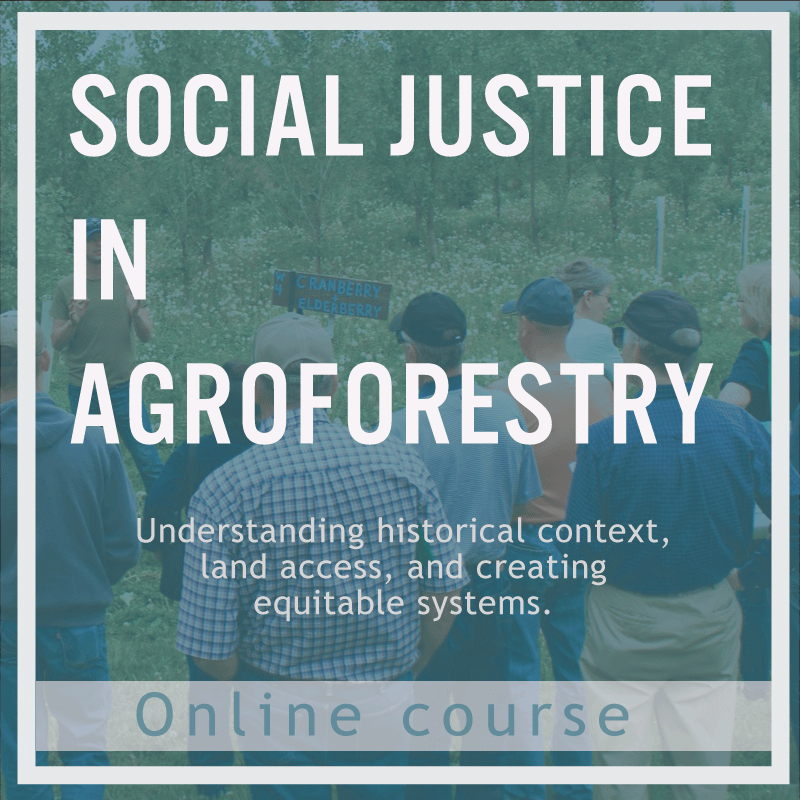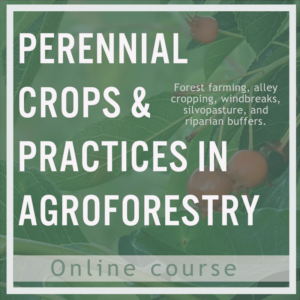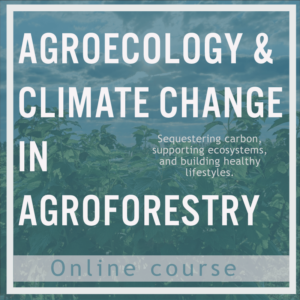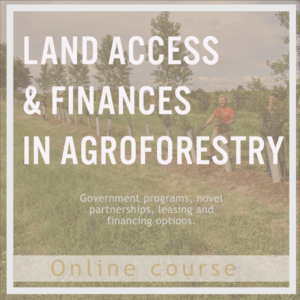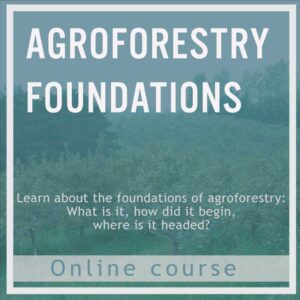In the Agroforestry Foundations Online Course, we asked you to reflect on the question, “Why are you interested in agroforestry?” People become interested in agroforestry for many different reasons: to reduce their reliance on farm inputs, to improve financial viability through profitable tree crops, to grow food more sustainably, to improve community food security, to reclaim cultural practices, or any number of other reasons.
For many people, at least part of their interest lies in being an active participant in an agricultural system that is more environmentally regenerative, economically viable, and socially responsible than the current dominant US agricultural system. Creating a more regenerative and equitable agricultural system through agroforestry, however, requires us to recognize and address the injustices that have led to, and continue to shape, the current system. In Lesson 1 of this course, we critically examine how current regenerative and sustainable agriculture movements often overlook who is benefiting from these transitions and how this oversight can perpetuate social injustice. In Lesson 2, we examine the historical foundations of injustice in alternative agriculture movements by building an understanding of how racism is entangled in US agriculture and how profits are often prioritized over landscape and human well-being. In Lesson 3, we will apply the knowledge from Lessons 1 and 2 to our understanding of how to engage in more socially just agroforestry movements today.
We recommend that you borrow or purchase the book “Farming While Black” as a companion to this course. A few assigned readings in this course are from this book, although we do not provide access to it. Your ability to fully understand and engage with the course content will be enhanced if you have access to the book, so please consider borrowing or purchasing it.
Intended Audience
The concepts and analyses of racism in the articles, videos, and podcasts of this course are important for people from all backgrounds to understand so that we can work toward justice. However, some resources may be less useful to people of color who have more immediate lived experiences of racial oppression, and will be most relevant for white practitioners, organizers, and agricultural support providers. To the former audience, please feel free to take what is useful, and leave what is not.
To the latter audience, many of the concepts in this module may be challenging, and possibly new. Discomfort with this work is common and may bring up some strong emotional reactions. Feelings of shame and grief for the world as we knew it are common reactions, though that is not our intent. This discomfort is an important part of the process of investigating and challenging beliefs and assumptions. As August Ball of Green City Conservation describes, “this work is like the key difference between massage and physical therapy--the intent is not to be harmful or painful, but this discomfort is catalytic to the work.” Staying in our comfort zone does not allow us to move forward and to face the things that need to be faced. We encourage you to approach this course with an open mind and to work through the material to the end of the course. You may find it helpful to take breaks, revisit topics, and reflect along the way.
Our intent is not to change the way you think in specific ways, but to inspire you to challenge your beliefs and assumptions given new information that you are not expected to have previously encountered. We also recognize that this work is iterative and not linear--we all are learning, making mistakes, and continuing to strive.
Essential Questions
- How do mainstream regenerative and sustainable agriculture movements perpetuate injustice?
- How has racism shaped the current dominant US agricultural system?
- How can agroforestry movements contribute to not only environmental change, but also social justice?
Learning Objectives and Content Topics
- Recognize that transitioning to agroforestry requires more than practitioners’ changing their practices alone
- Recognize that in order for agroforestry movements to be truly regenerative and sustainable, they must focus on social justice
- Recognize that a complex web of social forces has driven change in US agricultural systems
- Define white supremacy, systemic racism, and settler colonialism
- Define intersectionality and be able to reflect on your position in agroforestry spaces
We will cover the following topics and lessons in this course:
Introduction
- Module Overview
- Intended Audience
- Essential Questions
- Learning Objectives and Content Topics
- Self-reflection break
Lesson 1: Defining terms and Introduction to Injustice in Regenerative and Sustainable Agriculture Movements
- Farmer Voices
- Whiteness in alternative agricultural movements
- Self-reflection break
- References
- Supplemental Resources
- Foundational contributions made by BIPOC communities to sustainable and regenerative agriculture
- Innovations by Black farmers remain at the core of sustainable agriculture today
- Supplemental Resources
Lesson 2: Injustice in the US Agricultural System
- Farmer Voices
- What’s the problem?
- Indigenous agroforestry
- Stolen land and labor
- Theft of land from Native Americans
- Theft of labor and land from Black farmers
- Exploitation of immigrant farmworkers
- Consolidation and concentration of power
- Intersectionality
- Reflection Questions
- Supplemental Resources
Lesson 3: Dismantling Racism in US Agriculture
- Farmer Voices
- What is decolonization?
- Dismantling racism
- Agroforestry-specific applications
- Supplemental Resource
Who should take this course? Those new to agroforestry, beginners, and dreamers. Throughout the course, we purposefully refer to people as agroforesters, practitioners, stewards etc., recognizing that not all people interested in beginning agroforestry projects identify as a farmer. Additionally, agroforestry projects can get started in rural and urban locations and everywhere in between. We also welcome those wanting to learn more about agroforestry in order to teach others the benefits of agroforestry.
So let’s get started!


